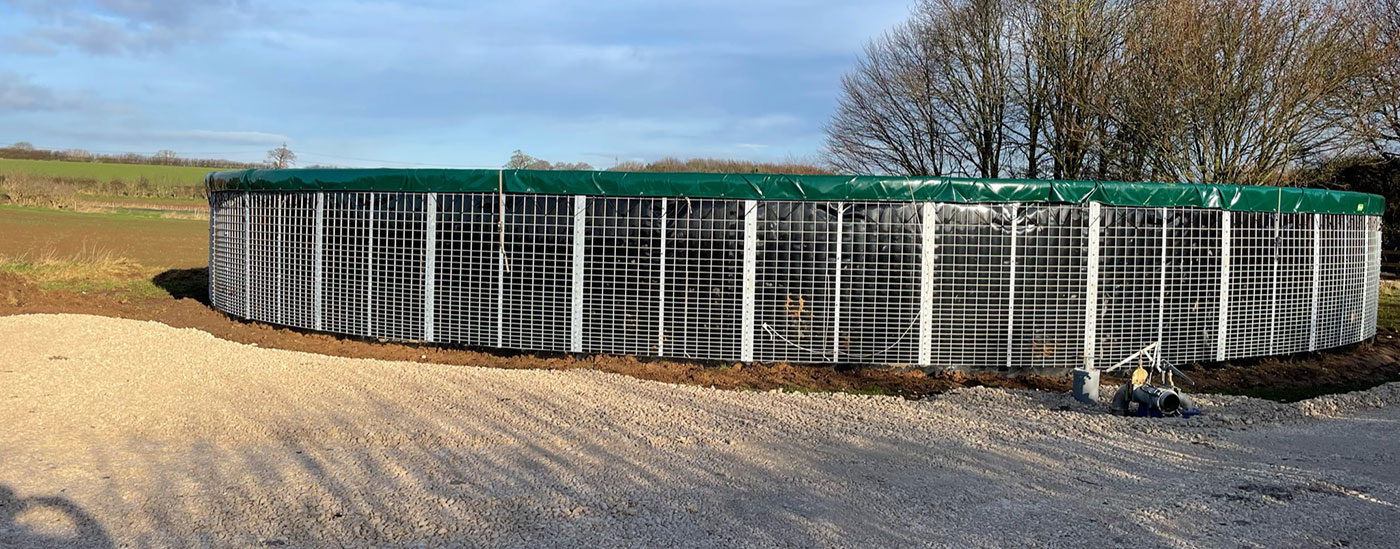The price of slurry stores can vary greatly depending on the size and the style of storage you wish to use. Some stores are typically more expensive than others, with lagoons costing the least and shuttered concrete stores costing the most. Typically the larger a slurry store, the more you have to pay, but choosing an unusually small slurry store can also cause the price to rise.
Digestate Storage
Send us a message

AWSM specialise in the specification, provision and installation of cost effective digestate storage solutions. Investing in compliant digestate storage infrastructure ensures farms can capitalise on the benefits digestate can bring. Storage solutions offered by AWSM are tailored to meet individual farm requirements and are compliant with Environmental Regulations.
In recent years the increased use of digestate has resulted in a significant demand for digestate storage solutions. As the sole UK importer of the Genap Mesh Silo Systems, AWSM offers a unique edge over other providers of digestate storage.
Digestate Storage Specifications:
Best practise is for digestate storage facilities to be constructed in line with Environmental Regulations and guidance including The Water Resources (Control of Pollution) (Silage, Slurry and Agricultural Fuel Oil) (England) Regulations 2010 and CIRIA C759 Livestock manure and silage storage infrastructure for agriculture. AWSM supply storage systems in compliance with these standards.
Digestate Storage Benefits
Digestate is a valuable fertiliser. Correct storage of digestate provides many benefits including:
- Improved fertiliser efficiency by allowing for controlled application at the time of optimum nutrient uptake by the crop
- Cost savings through optimised spreading practices
- Reduced environmental impact by minimising nutrient loss and ammonia emissions
- Compliance with Environmental Regulations
Spreading Times & ROI
Digestate should be applied during the growing season, typically from late winter through spring and summer, as this is when crops are actively taking up nutrients and can best utilise the nitrogen content of digestate.
In line with the Farming Rules for Water, storage of digestate should enable digestate applications to planned, giving consideration to:
- Optimal time: When crops are actively growing, usually from late winter to the end of summer.
- Crop specific needs: Consider the specific nutrient requirements of the crop you are growing when determining application rates.
- Avoid heavy rain: Don not apply digestate if heavy rain is forecast within 48 hours.
- Soil conditions: Avoid applying on snow covered, waterlogged or frozen soil as this is likely to result in pollution. Farmers should anticipate storing their digestate for longer periods of time during period of inclement weather.
When correctly specified and managed, digestate storage offers a sound return on investment, resulting in significant savings, up to four times against the value of crops that have been treated early or when digestate replaces bagged or standard fertiliser.
AWSM Digestate Storage Solutions
AWSM offer a full range of storage options and associated services for the specification, supply, and installation of digestate storage systems including above ground Mesh Silo Systems tanks lagoons.’
Upon screening for a suitable location, the Mesh Silo systems installed by AWSM only require a level soil base in terms of ground preparation, therefore our highly skilled installation team is able to install these types of tank in as little as 48 hours.
In addition, it is worth noting that the Mesh Silo Systems supplied and installed by AWSM do not require full planning permission, are easily relocated and can be asset financed if required. This digestate storage solution is ideal to ensure availability of fertiliser at the optimum spreading times and ensuring a good ROI.
In addition, AWSM offer custom designed lagoons which are built to meet a farm’s needs, based on their storage requirements and can be fitted with a floating cover to protect the digestate product by reducing the volume of rainfall entering the lagoon and ammonia volatilisation. Lagoons are typically constructed to hold up to 10,000m3 using a single sheet liner. For larger lagoons liner sheets are welded together to ensure specific client requirements are achieved and Environmental Regulations complied with.
Digestate Storage Capacity and Costs
The amount of digestate storage required for your farm depends entirely upon the farms land bank, nutrient requirement of the crops and frequency of application.
Different land uses, soil types and crops grown will affect how and when application of digestate can be beneficial. The most efficient way to determine a farms digestate requirements is by establishing a Nutrient Management Plan which will detail how much digestate is required and storage capacity can be tailored to meet these requirements.
The cost of storage varies greatly depending upon the volume of digestate to be stored and the construction method.
For further details or to discuss your digestate storage requirements get in touch with AWSM today.
Can anaerobic digestion work without thermal storage?
For bacteria to turn liquid into digestate effectively, the contents of a digester can be heated to maintain the ideal temperature for the process. When creating digestate, that sits around 30 to 38C. However, the process will still occur naturally if the liquid isn’t heated, albeit much slower and with decreased efficiency.
How much digestate storage is required?
The amount of digestate that is required for your farm depends entirely on how much land you have and how often you’ll need to apply it. Different land uses, soil types and crops grown will affect how and when digestate can be beneficial. The best way to determine how much you need is to speak with us and explain your situation, where we can offer our advice.



